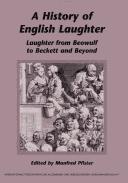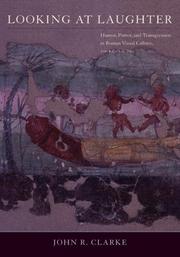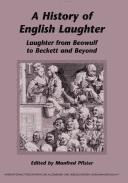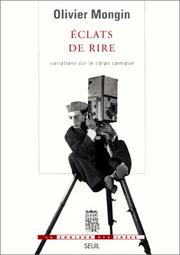| Listing 1 - 10 of 12 | << page >> |
Sort by
|
Book
ISBN: 9782729709181 2729709185 Publisher: Lyon cop. 2017
Abstract | Keywords | Export | Availability | Bookmark
 Loading...
Loading...Choose an application
- Reference Manager
- EndNote
- RefWorks (Direct export to RefWorks)
Laughter in art --- Music --- Musical analysis --- Social aspects --- Themes, motives --- Muziek --- Filosofie en esthetica

ISBN: 9789004484870 9789042012882 Year: 2002 Publisher: Leiden; Boston : BRILL
Abstract | Keywords | Export | Availability | Bookmark
 Loading...
Loading...Choose an application
- Reference Manager
- EndNote
- RefWorks (Direct export to RefWorks)
Is there a 'history' of laughter? Or isn't laughter an anthropological constant rather and thus beyond history, a human feature that has defined humanity as homo ridens from cave man and cave woman to us? The contributors to this collection of essays believe that laughter does have a history and try to identify continuities and turning points of this history by studying a series of English texts, both canonical and non-canonical, from Anglosaxon to contemporary. As this is not another book on the history of the comic or of comedy it does not restrict itself to comic genres; some of the essays actually go out of their way to discover laughter at the margins of texts where one would not have expected it all - in Beowulf, or Paradise Lost or the Gothic Novel. Laughter at the margins of texts, which often coincides with laughter from the margins of society and its orthodoxies, is one of the special concerns of this book. This goes together with an interest in 'impure' forms of laughter - in laughter that is not the serene and intellectually or emotionally distanced response to a comic stimulus which is at the heart of many philosophical theories of the comic, but emotionally disturbed and troubled, aggressive and transgressive, satanic and sardonic laughter. We do not ask, then, what is comic, but: who laughs at and with whom where, when, why, and how?.
Laughter in art --- Laughter in literature --- Laughter --- Wit and humor --- History
Book
ISBN: 2130672914 Year: 1995 Publisher: Paris cedex 14 (Humensis 170 bis, boulevard du Montparnasse 75680) : Presses Universitaires de France,
Abstract | Keywords | Export | Availability | Bookmark
 Loading...
Loading...Choose an application
- Reference Manager
- EndNote
- RefWorks (Direct export to RefWorks)
Cette édition numérique a été réalisée à partir d'un support physique, parfois ancien, conservé au sein du dépôt légal de la Bibliothèque nationale de France, conformément à la loi n° 2012-287 du 1er mars 2012 relative à l'exploitation des Livres indisponibles du XXe siècle. À la Renaissance, époque joyeuse, s'élabore une théorie du rire, œuvre surtout des médecins. Aidés par les philosophes, ils découvrent sa complexité. Mais le rire possède pour eux quelque chose de démesuré, lié à certaines formes de culture populaire. Rire, oui, mais à condition que la raison puisse se servir du rire. « Copyright Electre »
European literature --- Laughter --- Laughter in art. --- Laughter in literature. --- Smiling in art. --- Smiling in literature. --- History and criticism. --- Religious aspects.

ISBN: 9780520237339 0520237331 Year: 2007 Publisher: Berkeley, Calif.: University of California press,
Abstract | Keywords | Export | Availability | Bookmark
 Loading...
Loading...Choose an application
- Reference Manager
- EndNote
- RefWorks (Direct export to RefWorks)
In this fresh, accessible, and beautifully illustrated book, his third to examine an aspect of Roman visual culture, John R. Clarke explores the question, "What made Romans laugh?" 'Looking at Laughter 'examines a heterogeneous corpus of visual material, from the crudely obscene to the exquisitely sophisticated and from the playful to the deadly serious--everything from street theater to erudite paintings parodying the emperor. Nine chapters, organized under the rubrics of Visual Humor, Social Humor, and Sexual Humor, analyze a wide range of visual art, including wall painting, sculpture, mosaics, and ceramics. Archaeological sites, as well as a range of ancient texts, inscriptions, and graffiti, provide the background for understanding the how and why of humorous imagery. This entertaining study offers fascinating insights into the mentality of Roman patrons and viewers who enjoyed laughing at the gods, the powers-that-be, and themselves.
Wit and humor in art --- Arts, Roman --- Arts, Roman. --- Wit and humor in art. --- Laughter in art --- Humour dans l'art --- Arts romains --- Rire dans l'art
Book
ISBN: 9782503549460 2503549462 Year: 2018 Publisher: Turnhout: Brepols,
Abstract | Keywords | Export | Availability | Bookmark
 Loading...
Loading...Choose an application
- Reference Manager
- EndNote
- RefWorks (Direct export to RefWorks)
Comment rit-on de et par les images à l'époque de Rabelais? Le discours sur l'art n'intègre officiellement la dimension comique qu'au XVIIe siècle, pour la reléguer d'emblée au plus bas de sa hiérarchie des genres. Pourtant, le rire est abondamment présent dans les arts figuratifs de la Renaissance, un phénomène d'autant plus captivant qu'il échappe encore à tout classement homogène. Il s'empare de la sphère profane comme sacrée, joue d'une variété de registres du plus vulgaire au plus raffiné et prend des formes très diverses. En interrogeant ses représentations, mais aussi ses processus et ses effets, le livre explore la poïétique du rire au sein de la création artistique et de la pratique des images dans l'Europe des XVe et XVIe siècles.
Renaissance --- humor --- Art --- anno 1400-1499 --- anno 1500-1599 --- Rire --- Dans l'art Renaissance --- Laughter in art --- Art, Renaissance --- Congresses --- Wit and humor, Pictorial --- Themes, motives --- Dans l'art Renaissance. --- Laughter in art - Congresses --- Art, Renaissance - Themes, motives - Congresses --- Wit and humor, Pictorial - Congresses --- lachen

Abstract | Keywords | Export | Availability | Bookmark
 Loading...
Loading...Choose an application
- Reference Manager
- EndNote
- RefWorks (Direct export to RefWorks)
English literature --- Thematology --- Esprit et humour --- Geestigheid and humor --- Lach in de kunst --- Lach in de literatuur --- Laughter in art --- Laughter in literature --- Rire dans l'art --- Rire dans la littérature --- Wit and humor --- Geestigheid en humor --- Laughter --- England --- History

ISBN: 2020517000 9782020517003 Year: 2002 Volume: 3 Publisher: Paris: Seuil,
Abstract | Keywords | Export | Availability | Bookmark
 Loading...
Loading...Choose an application
- Reference Manager
- EndNote
- RefWorks (Direct export to RefWorks)
Laughter --- Laughter in art --- Wit and humor --- Comedy films --- Rire --- Rire dans l'art --- Humour --- Films comiques --- History and criticism --- Histoire et critique --- History and criticism. --- Comedy films - History and criticism.

ISBN: 2867811007 Year: 1990 Publisher: Bordeaux Presses universitaires de Bordeaux
Abstract | Keywords | Export | Availability | Bookmark
 Loading...
Loading...Choose an application
- Reference Manager
- EndNote
- RefWorks (Direct export to RefWorks)
Art, Medieval --- Laughter in art --- Laughter in literature --- Literature, Medieval --- Middle Ages --- European literature --- Medieval literature --- Congresses --- History and criticism&delete& --- Iconography --- Thematology --- Comparative literature --- anno 1200-1499 --- History and criticism
Book
ISBN: 9783795425838 3795425832 Year: 2012 Publisher: Regensburg Schnell & Steiner
Abstract | Keywords | Export | Availability | Bookmark
 Loading...
Loading...Choose an application
- Reference Manager
- EndNote
- RefWorks (Direct export to RefWorks)
History of civilization --- Art --- kunst --- cultuurgeschiedenis --- iconografie --- iconologie --- lachen --- humor --- middeleeuwen --- beeldhouwkunst --- tekenkunst --- 7.041 --- 7.033 --- Exhibitions --- Art, Medieval --- Christian art and symbolism --- Civilization, Medieval --- Laughter in art --- Laughter --- Laughing --- Emotions --- Nonverbal communication --- Wit and humor --- Medieval civilization --- Middle Ages --- Civilization --- Chivalry --- Renaissance --- Religious aspects&delete& --- Christianity --- History --- Religious aspects --- RIRE --- Rire --- HISTOIRE --- MOYEN AGE --- Dans l'art --- Moyen Age
Book
ISBN: 9782271081490 2271081491 Year: 2016 Publisher: Paris : CNRS éditions,
Abstract | Keywords | Export | Availability | Bookmark
 Loading...
Loading...Choose an application
- Reference Manager
- EndNote
- RefWorks (Direct export to RefWorks)
Une étude consacrée au rire qui en souligne le rôle social. Elle présente ses principes de base, notamment en anthropologie, de la Renaissance à aujourd'hui, ainsi que ses manifestations dans l'art, la philosophie, la littérature ou encore dans les médias. ©Electre 2017
Rire --- Aspect social --- Laughter --- Wit and humor --- Humour --- Social aspects. --- Philosophy. --- History and criticism. --- Philosophie --- Histoire et critique --- Humour dans l'art. --- Humour dans la littérature. --- Laughter in art. --- Laughter in literature. --- Rire dans l'art. --- Rire dans la littérature. --- Wit and humor in art. --- History. --- Aspect social. --- Histoire. --- Philosophie.
| Listing 1 - 10 of 12 | << page >> |
Sort by
|

 Search
Search Feedback
Feedback About UniCat
About UniCat  Help
Help News
News